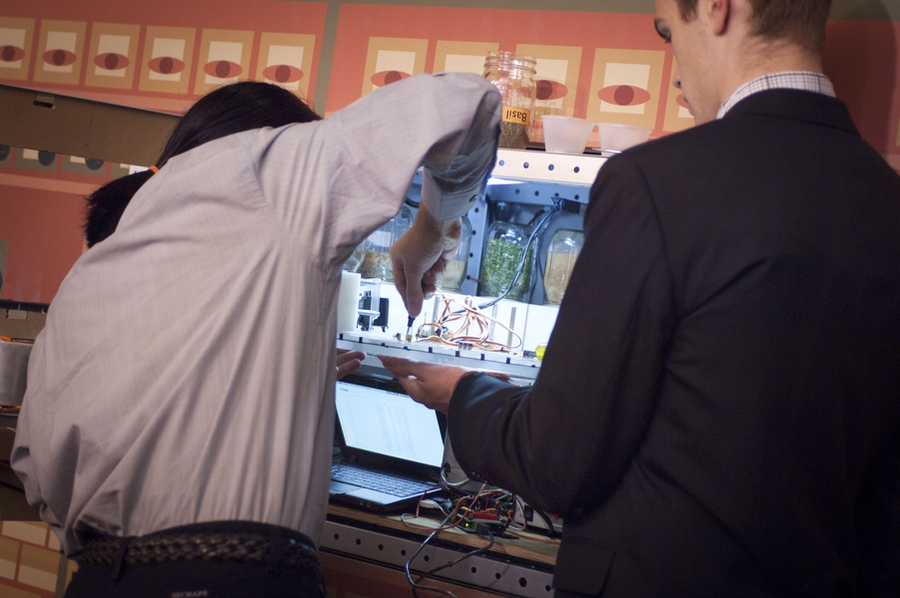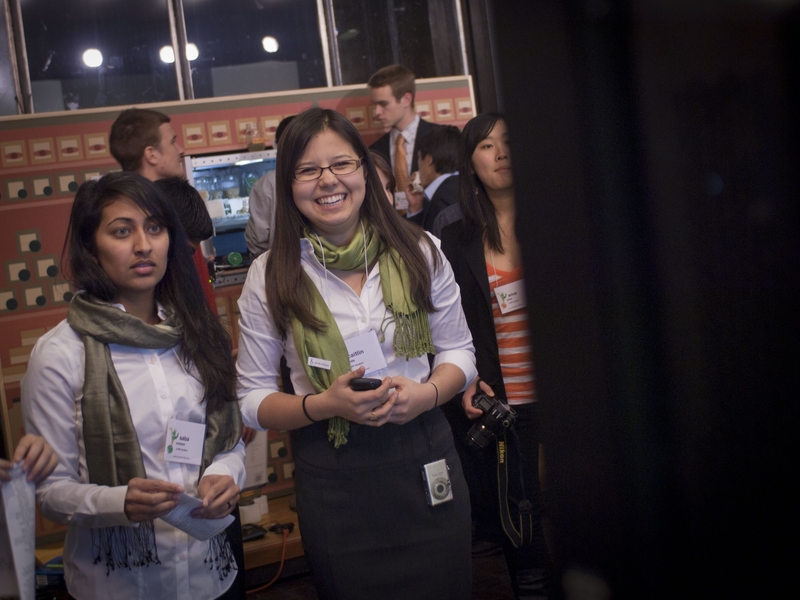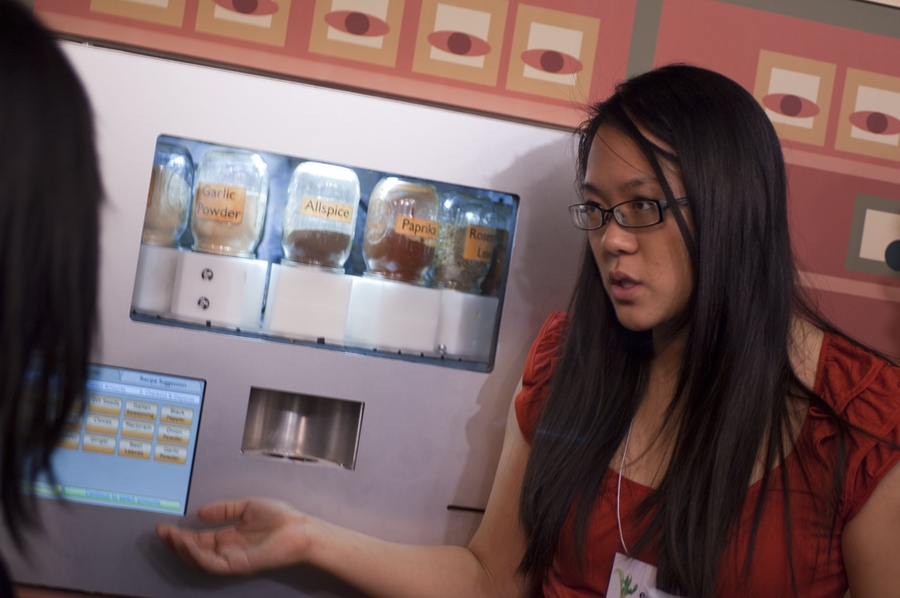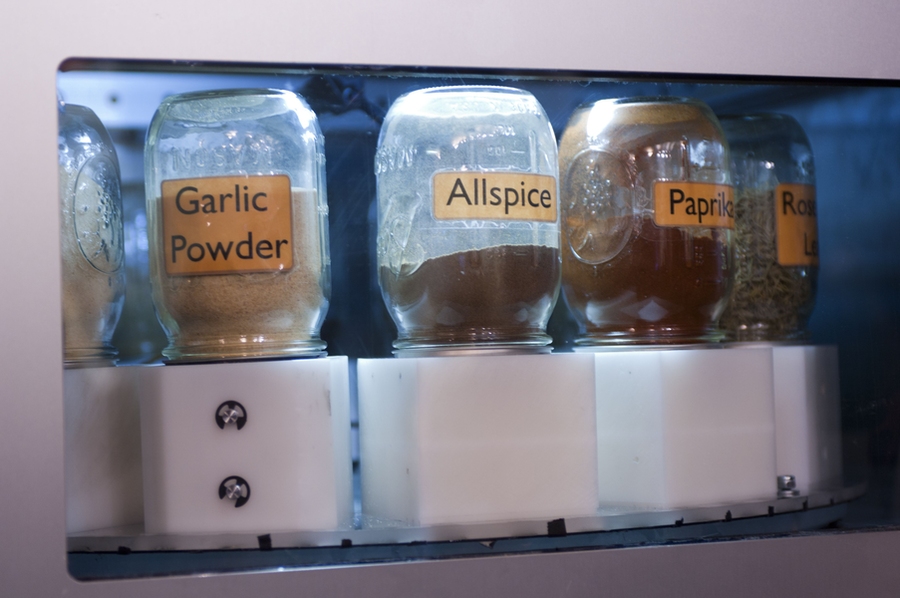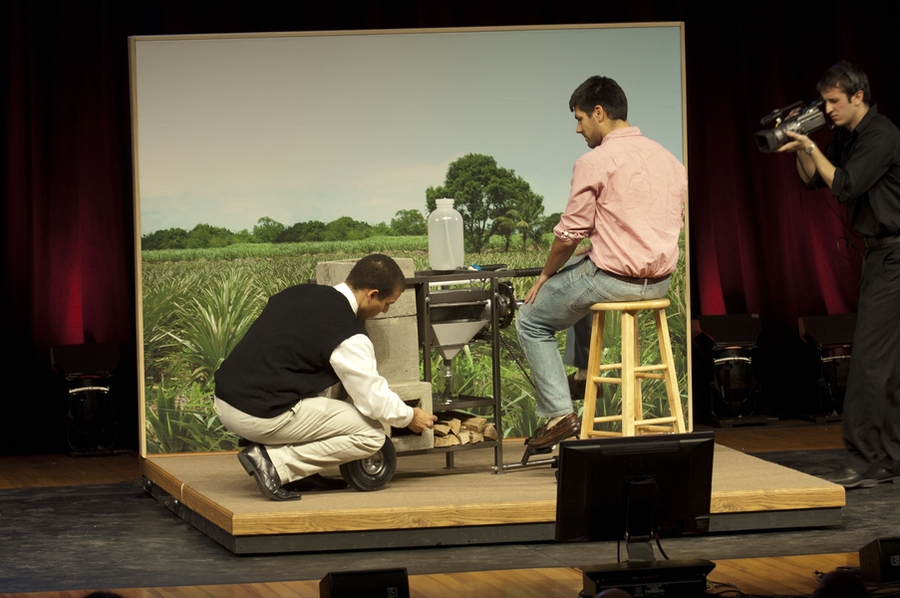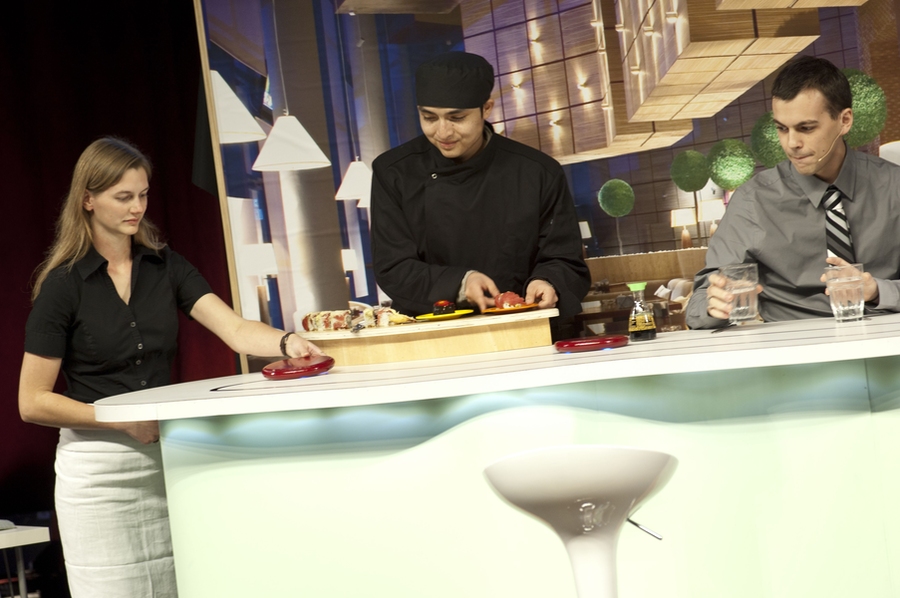Shopping at a supermarket presents challenges for people who use wheelchairs. There are basically three choices: Perch a supermarket basket precariously (and uncomfortably) on your lap, try awkwardly to push around a standard cart from a sitting position where it’s difficult to reach in, or use a basket-equipped store-owned scooter, which means leaving the user’s own wheelchair — possibly an expensive, custom-built model — at the front of the store where it might be stolen.
But a team of students in Product Engineering Processes, the MIT mechanical-engineering class better known by its course number, 2.009, came up with a neat solution to this dilemma: a collapsible basket that can conveniently attach to a wheelchair and can carry up to 40 pounds — more than enough for a typical grocery run.
The basket, called “Grocery Mate,” was one of eight prototype products demonstrated on Monday night to an enthusiastic crowd at MIT’s Kresge Auditorium, in the final class presentations of the term projects. Like all the prototypes presented, the basket had gone all the way from initial brainstorming to a polished product and a business plan in less than three months.
The challenge presented to the class in September was broad: Design a device that has something to do with the production, processing, marketing or use of food. And the teams responded with a wide array of ideas. There were devices for farmers: a more-efficient way of washing eggs, designed for small chicken farms, and a way of making powdered milk, for dairy farmers in developing countries whose output might otherwise spoil before it could get to market, powered just by a wood fire and bicycle pedals. And there were devices for consumers, including a system for quickly and conveniently measuring flour, another for dispensing precise amounts of different spices, and the basket for wheelchair users.
There were also devices for restaurant owners: a Roomba-like robotic system that could follow a line along a countertop to deliver trays of sushi to customers, and a device for cutting potatoes into a precise shape used in many French restaurants, called a tourné. And there was even a device that could be installed in health clubs to wash, sterilize and refill water bottles.
To build the prototypes, each team was allotted a budget of $6,500 and had a team of mentors to help with ideas, design, testing and marketing plans. This year, 151 students — a record — took the class.
Easy to use
Colleen Rock, a freshman who has been using a wheelchair for about seven years and drives a specially equipped van, helped with the testing of “Grocery Mate” and said, “It would definitely make shopping a lot easier for me. I really hope they do continue with it.” Rock, who was not part of the class, said that although add-on devices for wheelchairs exist, most are designed to be permanently mounted, while this design “offers more independent users something that won't interfere with their activities, because it's easily removable.”
The wheelchair device is simple to install and use. It consists of three basic components: a clamp that attaches to the frame of the wheelchair (which can be customized to fit the angle and diameter of a given frame), a bracket that fits into this clamp, and a collapsible plastic basket that slides onto a horizontal bar on the bracket. Once in place, the basket easily pivots out of the way to allow the user to reach groceries on the shelf, then swings back into place in front of the user to provide easy clearance as the chair rolls through the aisles.
The Purple Team gives their presentation of "Grocery Mate"
Video: Laird Nolan/Steven Keating/David Wallace
“One of the biggest challenges,” said Meagan Roth, one of the 18 members of the team that developed on the add-on, “was to allow for different angular configurations” on the wheelchair’s frame. To deal with the variations, the team designed a set of different brackets for each possible angle; customers would choose the right angle brackets for their particular style of chair, while all other components of the system would be standardized.
Setting up the basket takes only about 30 seconds. When the basket is folded down flat, it can be used as a desk surface, for example to hold a laptop computer. The whole thing could be built for about $80 and sold for $200, the team estimates.
While the point of the class is to instill a set of product-design and engineering skills in the students — not necessarily to design real products — some students who took the class in previous years have commercialized their products. This year, at least some of the students hope to follow that lead. For example, members of the team that developed the system for making powdered milk say they hope to address some problems with the present model and then take the improved version to Guyana in January for field testing.
At the end of the final presentations, senior Elizabeth Eddison, who was a member of the tourné-maker team, presented a poster signed by all the class members to professor David Wallace, the course creator and lead instructor. In their written comments, she said, more than half of the students remarked that 2.009 was the best class they had taken at MIT.
But a team of students in Product Engineering Processes, the MIT mechanical-engineering class better known by its course number, 2.009, came up with a neat solution to this dilemma: a collapsible basket that can conveniently attach to a wheelchair and can carry up to 40 pounds — more than enough for a typical grocery run.
The basket, called “Grocery Mate,” was one of eight prototype products demonstrated on Monday night to an enthusiastic crowd at MIT’s Kresge Auditorium, in the final class presentations of the term projects. Like all the prototypes presented, the basket had gone all the way from initial brainstorming to a polished product and a business plan in less than three months.
The challenge presented to the class in September was broad: Design a device that has something to do with the production, processing, marketing or use of food. And the teams responded with a wide array of ideas. There were devices for farmers: a more-efficient way of washing eggs, designed for small chicken farms, and a way of making powdered milk, for dairy farmers in developing countries whose output might otherwise spoil before it could get to market, powered just by a wood fire and bicycle pedals. And there were devices for consumers, including a system for quickly and conveniently measuring flour, another for dispensing precise amounts of different spices, and the basket for wheelchair users.
There were also devices for restaurant owners: a Roomba-like robotic system that could follow a line along a countertop to deliver trays of sushi to customers, and a device for cutting potatoes into a precise shape used in many French restaurants, called a tourné. And there was even a device that could be installed in health clubs to wash, sterilize and refill water bottles.
To build the prototypes, each team was allotted a budget of $6,500 and had a team of mentors to help with ideas, design, testing and marketing plans. This year, 151 students — a record — took the class.
Easy to use
Colleen Rock, a freshman who has been using a wheelchair for about seven years and drives a specially equipped van, helped with the testing of “Grocery Mate” and said, “It would definitely make shopping a lot easier for me. I really hope they do continue with it.” Rock, who was not part of the class, said that although add-on devices for wheelchairs exist, most are designed to be permanently mounted, while this design “offers more independent users something that won't interfere with their activities, because it's easily removable.”
The wheelchair device is simple to install and use. It consists of three basic components: a clamp that attaches to the frame of the wheelchair (which can be customized to fit the angle and diameter of a given frame), a bracket that fits into this clamp, and a collapsible plastic basket that slides onto a horizontal bar on the bracket. Once in place, the basket easily pivots out of the way to allow the user to reach groceries on the shelf, then swings back into place in front of the user to provide easy clearance as the chair rolls through the aisles.
The Purple Team gives their presentation of "Grocery Mate"
Video: Laird Nolan/Steven Keating/David Wallace
“One of the biggest challenges,” said Meagan Roth, one of the 18 members of the team that developed on the add-on, “was to allow for different angular configurations” on the wheelchair’s frame. To deal with the variations, the team designed a set of different brackets for each possible angle; customers would choose the right angle brackets for their particular style of chair, while all other components of the system would be standardized.
Setting up the basket takes only about 30 seconds. When the basket is folded down flat, it can be used as a desk surface, for example to hold a laptop computer. The whole thing could be built for about $80 and sold for $200, the team estimates.
While the point of the class is to instill a set of product-design and engineering skills in the students — not necessarily to design real products — some students who took the class in previous years have commercialized their products. This year, at least some of the students hope to follow that lead. For example, members of the team that developed the system for making powdered milk say they hope to address some problems with the present model and then take the improved version to Guyana in January for field testing.
At the end of the final presentations, senior Elizabeth Eddison, who was a member of the tourné-maker team, presented a poster signed by all the class members to professor David Wallace, the course creator and lead instructor. In their written comments, she said, more than half of the students remarked that 2.009 was the best class they had taken at MIT.
